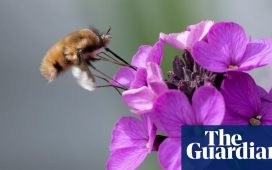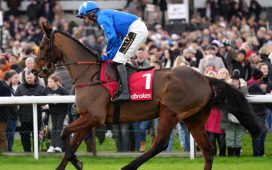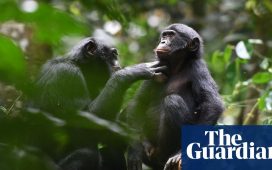‘The bears leapt off the rocks on to the whales’
Chadden Hunter, producer, North America and South America
We had heard about polar bears up in the Canadian Arctic hunting in an incredible new way during the summer when the sea ice has gone. There’s an area in the Hudson Bay where the water is shallow and tides rip in through boulder fields. Apparently, the bears climb up on to boulders and wait for beluga whales to swim past. Then they leap on to the backs of these beautiful snow-white giants, grab them and bite the back of their heads to try to kill them. It sounded unbelievable.
There is no coastguard up there, no help at all. Storms can whip up quickly and boats get turned over. One day, ours got stuck on a rock. The tide was rushing around and it was going to flip. We had to get out. The cameraman stripped down to his underwear and jumped into the freezing water to push the boat off. A curious polar bear, meanwhile, swam towards us and kept circling.
We had a rifle for safety. One day, while we were on shore, I went for a pee in some bushes, thinking it was safe because we’d scouted the area. All of a sudden, I see this big white lump just in front of me: a sleeping polar bear. I look over my shoulder and see my team and the guide who has the gun. They’re about 100m behind me.
So I’m trying to whistle like a bird to get their attention, without startling the bear. He lifts up his head and gives this indignant look, as if to say: “You call that a bird whistle?” I guess he was shocked at how bad my whistling was – but also by the fact that a human was standing there at all. So I’m trying to do my business with a polar bear staring me down, when another head rises up in the bush. Now I have two of them, 20m away, and my team are looking the other way, out to the ocean.
I whistled louder. Eventually they heard me – just as the polar bears stood up and I realised I could never have got to safety. But they took one look at me and decided to head in the other direction. I was lucky: they were well fed.
‘We sat motionless in -10C every night for a month’
Justine Evans, camera operator for Europe and Australia

Wolves are highly nocturnal, which makes them notoriously difficult to film. We were in Abruzzo, the national park in southern Italy, staking out entire areas. Wolves hunt across the mountains there but they could be anywhere. So it’s like trying to find a needle in a haystack.
It took a month of nights, sitting motionless in -10C for hours on end. There were just two of us. I looked like the Michelin Man in down trousers and a down jacket, like a big pudding. There were sheepdogs around too. They’d suddenly appear in the middle of the night and scare the living daylights out of you.
We staked out one area for over a week, saw the odd deer wandering past, but no wolves. That was demoralising. Then we got a report of a wolf kill, a deer carcass on another site. We went there and three wolves appeared that night. And then they started hunting, which was incredible. They’d chase deer down a slope and hope they tripped. Can you imagine running hell for leather down a mountain in the pitch black? And yet the wolves often didn’t succeed. It was lots of effort for little reward.
Unbelievably, the sheepdogs would group together and steal the kills. The wolves were working so hard, then losing out. When I do night work like this, I often see things that have never been seen before. This was like a new frontier in nature.
‘We’ve just been shot at by poachers’
Giles Badger, producer of Europe and Africa
My producer Jo Haley was filming gorillas in the heart of Congo-Brazzaville and one night rang on the satellite phone. “We’ve just been shot at by poachers,” she said. “We’re having to evacuate.” The crew had been filming and suddenly heard two gunshots. They were up on a viewing platform to keep them away from forest elephants, which can be very dangerous. They felt like sitting ducks. So they had a very tough decision to make.
The one rule of the forest is that you don’t walk around after dark. But at dusk, they took their essentials and walked for an hour to reach the safety camp. The next morning, the armed poaching patrols came in and said they had found the body of a slaughtered elephant. The crew felt it had to be the end of the shoot. The poachers were still on the run. There were armed people in the forest and the gorilla sequence never got finished.
‘The first thing we heard was a rhino singing’
Emma Napper, producer of Asia and Australia

There are fewer than 70 Sumatran rhinos left. In 10 years’ time, they may no longer exist, so they’re kept in a secret location behind fences within a national park. There had been just one recording made of them singing before. But when we got out of the car, the first thing we heard was a rhino singing – and it was loud.
They’re such lovely little rhinos, quite different from African ones. I’m five foot two and they’re shorter than me and a bit hairy. The jungle is so dense that if they want to find a mate they have to sing. It’s like the song of a humpback whale, an amazing, haunting sound. But their chances of finding a mate when there’s only 70 left across the whole island of Sumatra is slim to none.
‘When he saw the blows, he said: Abi, this is it!’’
Abigail Lees, assistant producer of Antarctica
The holy grail of wildlife-filming is to capture a great whale aggregation in Antarctica. We suspected something was happening in an area near Elephant Island, off the coast of Antarctica, but there was no way of telling whether the whales were just passing or how many were there. It was a gamble.

We ended up capturing a feeding aggregation, the first time this has ever been done. It was huge – 150 whales – and it all happened on the last day. When he saw the number of blows spouting from the water, my cameraman Gregory shook me and said: “Abi, this is it!” I was in shock.
We ran to get our drone, my heart was beating like mad. We sent it up then quickly brought it back down again to change the memory cards. After the second trip, it landed very hard and broke, so we had to run and find our backup drone, which could only fly for five minutes before the batteries needed replacing. We didn’t have time to change lenses either, so it’s all on this wide-angle lens, which turned out to be a good thing. Somehow that cut through the glare of the sea. That tiny drone ended up giving the best shots we got.
This is the first evidence that fin whales are recovering from whaling. They think 750,000 were slaughtered in the Southern Ocean alone, bringing their numbers down to a few thousand, mainly for margarine and soap. Which is insane – they’re just such simple household items.
‘If a diver got lost, we would scrape arrows in the ice above’
Fredi Devas, producer of Antarctica

Filming under sea ice is enormously difficult. First scientists drill a hole 9ft deep, then the team get into dry suits, drop down and swim off to their filming location, which can be a 20-minute journey. They need to know how to find their way back. GPS wouldn’t work under ice that thick.
They used to attach ropes to their ankles, but they’d get tangled. Now they just use their memories. We had this plan, whereby if someone wasn’t back in time, another person on the ice above would scrape out arrows with their boot, in the hope that the divers would look up and see them. It’s really low-tech.

You can’t get to Antarctica by aeroplane or helicopter. It’s too far. You have to sail: 10 days skirting along the Drake Passage, the roughest sea in the world. Our seasickness was so bad my cabin-mate only ate an apple for eight days. Otherwise it was just soup and vitamins. I had to check we were maintaining our sanity. We had done extensive first aid training, because the closest hospital was in the Falklands.
When you arrive at St Andrews beach after that 10-day sail, you see a colony of 500,000 king penguins and all these elephant seals. It’s an extraordinary sight. At one point, we were trying to film four-tonne male elephant seals fighting over the harem of females. A fight kicked off at high tide. We were up to our knees in the freezing sea for the whole day. When a couple of big waves washed over us, I thought: “These are great shots, but what risks are we taking?”
Towards the end, I was cleaning some kit when this huge group of penguins came on over and started looking inside my bag. I was there for about half an hour with them huddled around me, pecking at my back and the camera bits. I stayed very still, not wanting to disturb them, just quietly getting on with my job. Being surrounded by wildlife that doesn’t fear you was one of the most beautiful moments in my life.
• Seven Worlds, One Planet is on Sundays on BBC One and on BBC iPlayer.






